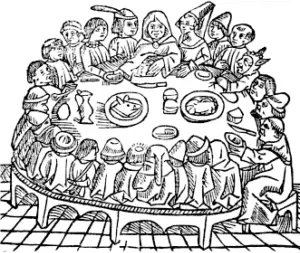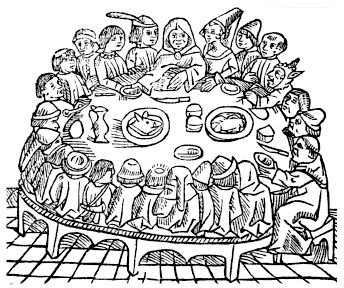The Canterbury Tales Characters: Significance of the 7 Main Roles
 Canterbury Tales in Short
Canterbury Tales in Short
“The Canterbury Tales” is actually a collection of short stories, all written in classical Middle English by the 14th-century poet, Geoffrey Chaucer. The stories themselves are diverse and filled with dozens of characters. However, the characters in the game that truly drive the story are those that play a pivotal role in all of the sections, whether in an obvious way or in a background fashion. Out of the characters of the stories, there are seven that are particularly relevant to the story as a whole.
The Narrator
The Narrator in the story represents Chaucer, of course. However, the narrator is also the voice of reason in the story. He is the only objective witness in the story because he tells things the way that they are.
The Knight
Arguably the main character of the story, the Knight is present in nearly all of the stories—at least in mention. He is the personification of all of the features any good courtier was supposed to have in the mid 14th century—prowess, fidelity, reputation, and generosity. In the stories, the Knight is the personification of refinement and ability. The reader is told that the Knight has fought Turks, Spaniards, Russians, Muslims, and Egyptians, indicating that he is a well-traveled and hardy fighter. The Knight represents chivalry, adventure, and valor in the story. He is arguably the only reliable and honorable character in the stories.
The Pardoner
The Pardoner is personified in the stories as a crook and an exploiter. Pardoners of the day were those who sold indulgences to religious folk who wanted to atone for their sins. The Pardoner in these stories is no different other than that he takes his job a little too joyously. The Pardoner is seen as someone who just wants to cash in on the weaknesses of the religious and then move on. He is a material man who desires for material things, ironically contrasting the stereotype of his position. The Pardoner is a representation of division and corruption, primarily in the church. What he sells as artifacts are actually pieces of junk, which personified Chaucer’s take on the church at the time.
The Wife of Bath
The archetypal housewife, the Wife of Bath is a home-hardened woman with a love for extravagance and night-life. She wears fine clothes and the most stylish fashions around. However, despite her outward fashion, she is a nagging woman, which fits the 14th-century stereotype of wives to a T. She is argumentative, intelligent and enduring—even through the transgressions of her husband. What is more is that she is a sexual being, using her sexuality as a tool against her husband or other men when they have something she wants. The Wife of Bath was the first desperate housewife. The Wife of Bath represents the common housewife as well as the commoner’s need for extravagance. During the time, commoners fantasized about the life of royalty; the Wife of Bath personifies this.
The Miller
The Miller fulfills the role in the story of the world-weary working man. He is a drunk and an oaf, ripping doors off of their hinges and verbally assaulting the narrator, the knight and the Wife of Bath extensively. He is also a lusty man, pining after the Wife of Bath, as well as the Prioress, one of the other females leads in the stories. He is something of the comic relief in the story, interrupting the tales of the narrator and breaking the fourth wall on several occasions. The Miller is the hard-working man. He is the common man trying his best to make his way in life. However, with hard-working commonality, he is also prone to the pitfalls of humankind—primarily, drunkenness and lust.
The Prioress
The chaste and refined woman of purity and love, the prioress is far more than what she tries to appear. Unlike the common thought of what a mother superior was supposed to be in the 14th century, the Prioress was a vain and gossiping woman with a tendency to stretch the truth to her will. She and the Wife of Bath are the two female lead characters in the story—both of which are the center of many men’s affections in the stories. Though she tried to appear deliberate and holy, the Prioress is much messier under the skin. It is debatable that Chaucer wanted her to represent the church as a whole—being consecrated on the outside, but just as dirty underneath as anyone else. Like the Pardoner, the Prioress represents a corruption of the church. She looks chaste and good, but, under the surface, she is as disgusting as any sinner.
The Friar
A roaming priest with no home church and no particular allegiance to any of the other characters in the story, the Friar readily befriends everyone that he meets. He particularly likes young women and rich men who can cater to what he needs or wants in the story. However, the narrator tells readers that he is highly susceptible to bribes, once again cluing the reader in on the fact that Chaucer was not necessarily the biggest supporter of the church of the 14th century due to corruption and money mongering. Like the prioress and the Pardoner, the Friar is a religious mercenary, less concerned with love and kindness than he is with personal prosperity. He further enhances Chaucer’s political outcry against the religious system of the day.
Focus on These Characters
Though the stories of the Canterbury Tales boast many more characters, these characters are the most intertwined and relevant to the story as a whole. Chaucer displays many themes in the stories, which are personified by these characters’ traits, desires, and flaws.
References
https://academic.brooklyn.cuny.edu/webcore/murphy/canterbury/ https://www.canterburytales.org/canterbury_tales.html Image courtesy of Wikimedia Commons
